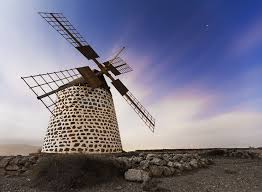THE WINDMILLS OF FUERTEVENTURA
An Article by Bernie Power with The Voice

Photo by Simon Waldram
Fuerteventura is a product of all the natural elements. An island born by fire, surrounded by water, adorned with seemingly barren earth, and enveloped by fast moving and powerful air. Air which fuelled an industry. The name Fuerteventura was first mentioned in 1339 on a map by Angelino Dulcert. He named it ‘The Island of Strong Wind’ and if you live here, you will attest to the truth of this!
The Early Windmills
In the middle of the 18th century the farmers of the island took advantage of the strong wind and built large windmills, in which to grind their corn. You will see them all over the island and most of them have now been restored. However, in some towns, like the old town in Corralejo, some skeletons still stand. Preserved yet battered by the ravages of time, lying in testament to the people that relied on them, literally for their daily bread.
There are two types of windmills here in Fuerte. The larger, two storey type, which are the original windmills known as El Molino or Los Molinos. These are known as male windmills, large, cumbersome, hard working and costly to maintain. The others are smaller, single storey buildings that were introduced much later, from mid 1800’s. These take on the feminine form of the name, and are known locally as La Molina or Las Molinas. These ladies are neater, easier to operate, much less work as they are built on a single floor and are far cheaper to maintain. Each windmill has a fantastic character and when you research them, a personal history of their own.
Standing Proud
Windmills came at a substantial expense, and care was taken to erect them in prime positions. They needed to be as close to the crop as possible, but in a perfect spot to take advantage of the strong Fuerteventura winds. In the village of Villaverde, often called the bread basket of Fuerteventura, there are two windmills that stand together. They stand tall and proud atop the hill, ready and waiting to catch the wind. They make a marvellous photograph opportunity and demonstrate the sheer amount of grain that needed to be processed, from the local fields in La Olivia, which they oversee.
Side by Side
Another two worth noting, and well worth a visit, can be found near the Eco Museum in Tefia. These are very unusual, as here you will see one of each type in the same vicinity. Unfortunately, you cannot venture inside but you can get close enough to get a good look at the construction methods that were used. If you want to see what lies behind the walls of these powerful machines from the past, then a trip to the village of La Asomada is needed. Here you can see all the gears and workings that were used to grind the grain. Just look for the tourist sign (just past Tetir) on the way to the airport. The original family still own the mill, and are more than happy to show you inside and explain what the life of a miller was like.
Simply Fascinating
Another fantastic example can be found in the village of Tindaya. However, the once working mill is now a private residence, after a debacle with the local council. And although it seems much more ancient in appearance, was only built in 1936 and is called La Molina de Tebeto. All the windmills across the island have individual names and stories to tell. And each is a fascinating remnant of times past, and a gentle reminder of the original and very simple industry that once sustained the proud and hard working people of the island.
 The Voice – Fuerteventura Keep up to date in Fuerteventura with The Voice Magazine
The Voice – Fuerteventura Keep up to date in Fuerteventura with The Voice Magazine


